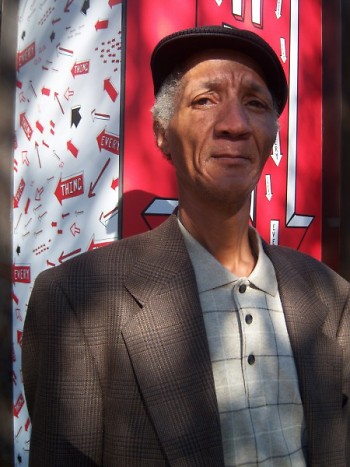It turns out to be the middle of the night when I start to come out of a watery dream, where I am visiting a friend from London in her outdoor garden hospital bed. In the garden there is music, and I struggle to find where it's coming from until I awake to realize that I've been in a dream. But there is still music when I wake up: beautiful, soulful singing in the middle of the night, coming from the hallway. Peeling my 6-year old daughter off of me, I crawl out of bed, and open the hotel door to hear Willie bellowing beautiful church hymns at the top of his lungs in the shared shower on our floor.
It's our last day in London, and in a few hours we'll make our usual trek down to the Museum. More art supplies have been purchased this week than normal, more walking than we do at home. Yesterday we met a group of 4 artists and their studio director, Charlotte, from Action Space in London. Mary doesn't speak much, but she sits down next to Willie to fill pages and pages with thick, wild sharpie marks. Her work is also featured in the exhibition: a large sculpture made out of mostly found objects, all cut to the same size and strung on endless wire. Charlotte and I talk about the importance of studios like Action Space and Heartside, how we share goals and yet have a vastly different artist base. For 16 years she's worked exclusively with artists who have learning disabilities and has a small support staff and budget to aid in her instruction-free approach to creative expression. She doesn't understand how Heartside isn't funded by the state or city, as a place who she says obviously offers needed, supportive outlets for a diverse group of folks who have many stories to tell. Indeed.
Later today Willie and I are to sit on a panel with Tom di Maria and Charlotte to talk about the methods and benefits of studio spaces like ours. The range of our studios seems ideal- we span from a 40+ year old, well-oiled non-profit who works with adults with physical and developmental disabilities (who have also partnered with Marc Jacobs on a clothing line), to a 15 year old drop-in studio struggling for funding and recognition, though abundant in stories, camaraderie and goals. At the end of the panel discussion, we'll leave a few more drawings for the Museum, say our goodbyes and pack our filled notebooks for later digestion. We've built a sort of odd and lovely family here, exchanging emails, funding tips, methods and anti-methods. If I ever needed confirmation that what we're doing is the right thing, I've received it back home, I've received it here.
The Rapidian, a program of the 501(c)3 nonprofit Community Media Center, relies on the community’s support to help cover the cost of training reporters and publishing content.
We need your help.
If each of our readers and content creators who values this community platform help support its creation and maintenance, The Rapidian can continue to educate and facilitate a conversation around issues for years to come.
Please support The Rapidian and make a contribution today.


